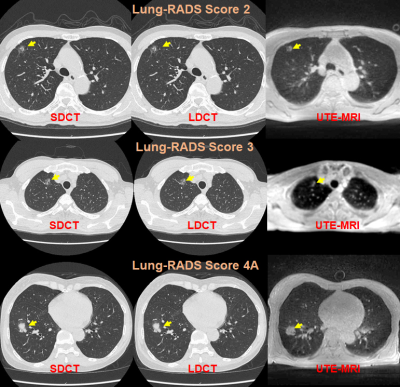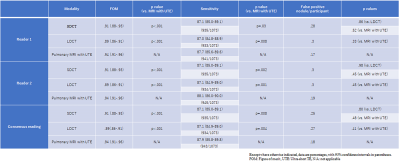0036
MRI with UTE: Capability for Nodule Detection and Lung RADS Classification as Compared with Standard- and Reduced-Dose CTs in Screening Cohort1Radiology, Fujita Health University School of Medicine, Toyoake, Japan, 2Joint Research Laboratory of Advanced Medical Imaging, Fujita Health University School of Medicine, Toyoake, Japan, 3Canon Medical Systems Corporation, Otawara, Japan, 4Diagnostic Radiology, Hyogo Cancer Center, Akashi, Japan, 5Radiology, Fujita Health University Hospital, Toyoake, Japan
Synopsis
No report has been found to compare nodule detection and Lung RADS classification capabilities in lung cancer screening cohort among pulmonary MR imaging with UTE, low-dose CT (LDCT) and standard-dose CT (SDCT). We hypothesized that pulmonary MR imaging with UTE has a similar potential to detect pulmonary nodules and evaluate Lung-RADS classification and can apply lung cancer screening as well as CT. The purpose of this study was to compare the capability for nodule detection and Lung RADS classification among pulmonary MR imaging with UTE, LDCT and SDCT in lung cancer screening population.
Introduction
National Lung Cancer Screening Trail (NLST) and The Dutch-Belgian Lung Cancer Screening trial (NELSON) reported the reduction in mortality with the use of low-dose computed tomography (LDCT) scan to screen high risk individuals1, 2. Therefore, major organizations have adopted or considered to apply LDCT for lung cancer screening in high risk populations. In addition, American College of Radiology has proposed Lung-RADS as a quality assurance tool to standardize lung cancer screening CT reporting and management recommendations, reduce confusion in lung cancer screening CT interpretations, and facilitate outcome monitoring3. Since 2016, pulmonary MR imaging with ultrashort TE (UTE) has been suggested as having a potential to detect nodule, evaluate lung parenchymal abnormality and play as substitution to LDCT as well as standard-dose CT (SDCT)4-6. However, no report has been found to compare nodule detection and Lung RADS classification capabilities in lung cancer screening cohort among pulmonary MR imaging with UTE, LDCT and SDCT. We hypothesized that pulmonary MR imaging with UTE has a similar potential to detect pulmonary nodules and evaluate Lung-RADS classification and can apply lung cancer screening as well as CT. The purpose of this study was to compare the capability for nodule detection and Lung RADS classification among pulmonary MR imaging with UTE (UTE-MRI), LDCT and SDCT in lung cancer screening population.Materials and Methods
205 participants (mean age 64 years±7 [standard deviation], 114 men) who met American College of Radiology appropriateness criteria for lung cancer screening with low-dose CT were examined with pulmonary UTE-MRI at three 3T system (Vantage Titan 3T and Vantage Galan 3T, Canon Medical Systems Corporation, Otawara, Japan) by respiratory-gated 3D radial UTE pulse sequence (TR 4.0ms/ TE 96-112μs, flip angle 5 degree, 1x1x1 mm3 voxel size), SDCT (270 mA) and LDCT (60 mA) at 64-detector row CTs (Aquilion 64, Canon Medical), 80-detector row CT (Aquilion Prime, Canon Medical), 160-detector row CT (Acquilion Precision, , Canon Medical) and 320-detector row CTs (Aquilion ONE, Canon Medical). According to SDCT findings, all detected nodules were classified by Lung RADS based on consensus or chest radiologists as well as pulmonologists. In each patient, probability of presence at each pulmonary nodule was assessed on all three methods by means of 5-point visual scoring system by two board certified chest radiologists. In addition, all nodules were classified based on Lung-RADS on each method by same radiologists. To compare nodule detection capability, Jackknife alternative free-response receiver operating characteristic (JAFROC) analysis were performed among all methods. Then, detection rates were also compared among three methods by McNemar’s test. To evaluate Lung-RADS classification capability, inter-observer agreement of each method was evaluated by kappa statistics with χ2 test. In addition, each agreement with standard reference was also assessed by kappa statistics with χ2 test were performed. Finally, Lung RADS classification accuracy were compared among all methods by McNema’s test. A p value less than 0.05 was considered as significant in this study.Results
Representative cases are shown in Figure 1. Results of JAFROC analysis are shown in Figure 2. For consensus evaluation, there were differences in FOM (p<0.001) among the three modalities (SDCT: FOM=0.91, LDCT: FOM=0.89, pulmonary MRI with UTE: FOM=0.94). Assessment of sensitivity for consensus evaluation showed that sensitivity of pulmonary MRI with UTE (87.9%) was higher than that of SDCT (87.1%, p=0.008) and of LDCT (87.1%, p=0.004). Inter-observer agreements for all modalities were almost perfect (standard-dose CT: κ=0.98, p<0.001; low-dose CT: κ=0.98, p<0.001; pulmonary MRI with UTE: κ=0.96, p<0.001). Agreements for Lung-RADS classification of all nodules based on consensus evaluation results for each modality are shown in Figure 3. Agreements for Lung-RADS using all modalities were almost perfect (standard-dose CT: κ=0.82, p<0.001; low-dose CT: κ=0.82, p<0.001; pulmonary MRI with UTE: κ=0.82, p<0.001). We found no evidence of differences in Lung-RADS classification accuracy among all three modalities (standard-dose CT: 81.9%, low-dose CT 81.7%, pulmonary MRI with UTE 81.7%; p>0.05).Conclusion
Pulmonary MRI with UTE is similar to standard- or low-dose CT s for nodule detection and Lung-RADS classification in a lung cancer screening population.Acknowledgements
This study was technically and financially supported by Canon Medical Systems Corporation.References
- National Lung Screening Trial Research Team, National Lung Screening Trial Research Team, Aberle DR, Adams AM, Berg CD, et al. Reduced lung-cancer mortality with low-dose computed tomographic screening. N Engl J Med. 2011; 365(5): 395-409.
- de Koning HJ, van der Aalst CM, de Jong PA, et al. Reduced Lung-Cancer Mortality with Volume CT Screening in a Randomized Trial. N Engl J Med. 2020; 382(6): 503-513.
- American College of Radiology. Lung CT Screening Reporting and Data System (Lung-RADS). Accessed at www.acr.org/Quality-Safety/Resources/LungRADS on 20 November, 2020.
- Ohno Y, Koyama H, Yoshikawa T, et al. Pulmonary high-resolution ultrashort TE MR imaging: Comparison with thin-section standard- and low-dose computed tomography for the assessment of pulmonary parenchyma diseases. J Magn Reson Imaging. 2016; 43(2): 512-32.
- Ohno Y, Koyama H, Yoshikawa T, et al. Standard-, Reduced-, and No-Dose Thin-Section Radiologic Examinations: Comparison of Capability for Nodule Detection and Nodule Type Assessment in Patients Suspected of Having Pulmonary Nodules. Radiology. 2017; 284(2): 562-573.
- Wielpütz MO, Lee HY, Koyama H, et al. Morphologic Characterization of Pulmonary Nodules With Ultrashort TE MRI at 3T. AJR Am J Roentgenol. 2018; 210(6): 1216-1225.
Figures

Figure 1. Examples for standard-dose (SDCT: Left), low-dose CT (LDCT: Middle) and pulmonary MR imaging with UTE in Lung-RADS Score 2 (1st line), Score 3 (2nd line) and Score 4A (3rd line).
Each method has no difference of radiological findings as well as Lung-RADS classification in each subject.

Figure 2. Results of JAFROC analysis for lung nodule detection.
For consensus evaluation, the three modalities (SDCT: FOM=0.91, LDCT: FOM=0.89, pulmonary MRI with UTE: FOM=0.94) had significant differences (p<0.001). Assessment of sensitivity for consensus evaluation showed there were significant difference among three methods (p<0.001).

Figure 3. Agreement for Lung-RADS classification of all nodules based on consensus reading results for each modality.
Inter-observer agreements of all methods are significant and almost perfect (κ=0.82, p<0.0001). There were no significant difference of Lung RADS classification among all methods (p>0.05).